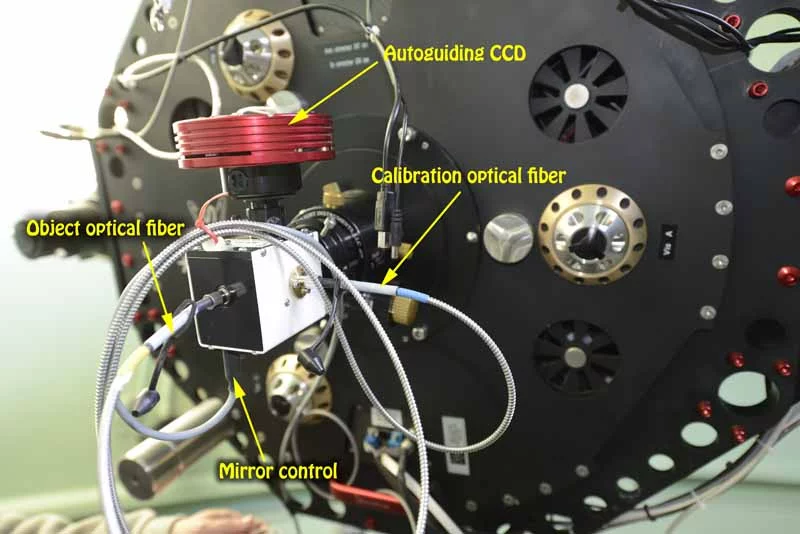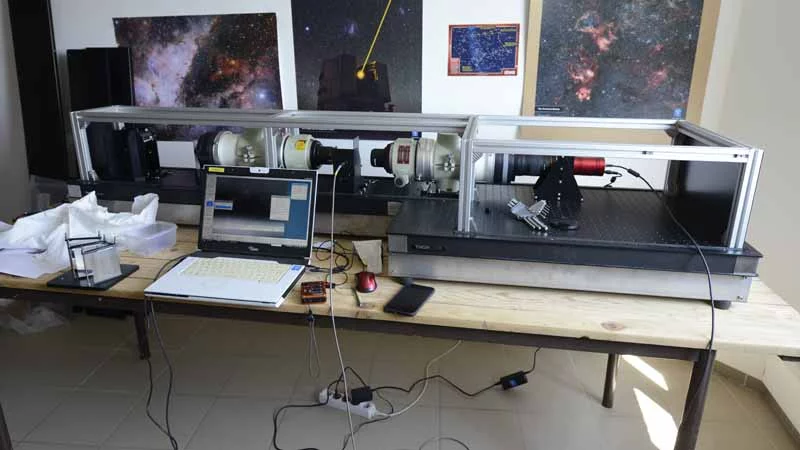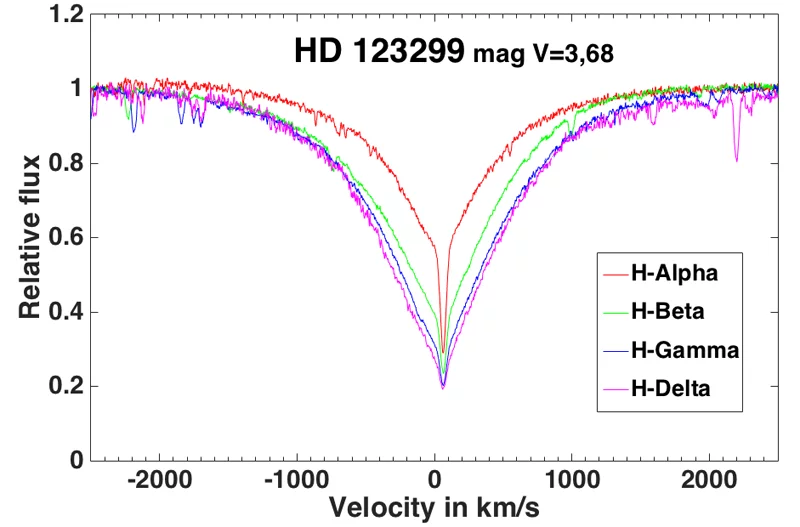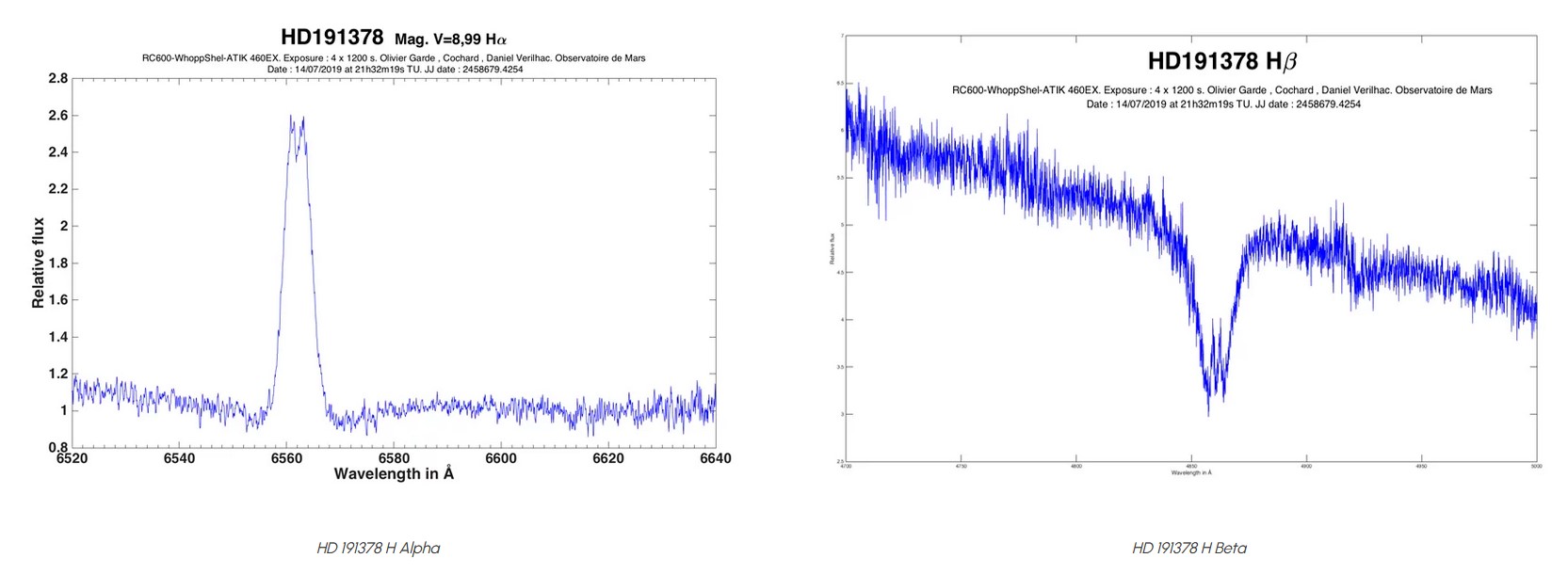from Olivier Garde

The Hubert Reeves Observatory at Mars in Ardèche
(Photo Olivier Garde)
The Whoppshel spectrograph has been designed for telescopes in the 0.6 to 1m diameter class (and even beyond). The R=30000 resolution of this instrument requires a significant diameter to collect enough light.
We have been asked several times what the magnitude limit is for this spectroscope on a 60cm telescope; to avoid giving a purely theoretical answer, we needed to carry out a full-scale test on a telescope of this diameter.
We had the opportunity to use the first Whoppshel for a few weeks on the RC600 telescope at the Hubert Reeves Observatory in Ardèche.
We would like to thank the Valeyrieux community of communes, which owns the telescope, as well as the Club d'Astronomie de Mars (CAM) and its president Daniel Verilhac, who warmly welcomed us, helped us set up the telescope and enabled us to make these observations on a fantastic instrument.
The Hubert Reeves Observatory
Situated in the commune of Mars in the Ardèche at an altitude of 1,030 m, the observatory enjoys a 360-degree clear horizon and a sky of the highest quality. A 4.50 m dome houses an Italian-made Officina Stellare telescope: a 600 mm diameter Ritchey-Chretien open at F/8. It is mounted on a German direct drive Nova 200 equatorial mount built by the French company Alcor System.

The RC600 on its Nova 200 mount
(Photo credit: Olivier Garde)
To inject the light collected by the telescope onto the 50µm optical fibre, we use a standard Shelyak Instruments close-up lens at F/6. As the telescope is open at F/8, we use an Astro-Physics CCDT67 focal reducer (x 0.67) to bring the telescope's native focal length down to F/5.4. Note that Shelyak Instrument can now offer guide vanes with several apertures, by integrating an internal focal reducer. It is thus possible to have close-up lenses at F/6, F/7, F/7.8 and F/9.

La bonnette montée sur le RC600
(Crédit photo : Olivier Garde)
Die Nahlinse wird zusammen mit dem Brennweitenreduzierer an der Okularhalterung des RC600 (2 Zoll) montiert. Sie erfüllt mehrere Aufgaben:
- Einspeisung des Lichtstroms in den Lichtleiter "Objekt", der mit dem Spektrografen verbunden ist.
- Autoguiding
- Erstellung von Kalibrierungsbildern (Flat, Spektrallampe, LED).
Zusammenbau des Whoppshel
Der Whoppshel ist ein maßstabsgetreuer Spektrograph, der auf einer optischen Bank montiert ist, die 2,10 m lang und an ihrer breitesten Stelle 0,6 m breit ist. Die Gesamtmasse beträgt ca. 80 kg.
 The whoppshel being assembled
The whoppshel being assembled
(Photo credit: Olivier Garde)
The various pre-assembled modules of the spectrograph are fixed to the optical bench: the optical fibre injection support, the 90-degree deflecting mirror, the 2 FSQ-106 Takahashi scopes, the grating module, the cross-disperser (prisms) and the CCD camera with its objective. The detailed construction of the instrument was described in this article.

Le cross-disperseur et la caméra CCD
(Crédit photo : Daniel Verilhac)
The cross-disperser module, which separates the different orders, consists of 3 custom-made prisms. They are precisely positioned on a support that is fixed to the spectrograph's optical bench at the exit of the second FSQ-106 telescope. The CCD camera is equipped with a 135mm lens open at F/2.

The assembled Whoppshel
(Photo credit: Olivier Garde)
The entire spectrograph is covered by a black metal cowling to protect it from stray light and dust. The assembly is very stable mechanically, but it is preferable for the part to also be stable in temperature during the acquisition of spectra if we want to measure precise radial velocities.
The results
We tested the spectrograph over several nights, thanks to Daniel Verilhac's regular presence at the observatory. He was able to produce several dozen spectra of stars despite the weather not always being favourable. In many cases, it would have been useful to rest longer on certain targets to improve the signal-to-noise ratio of the spectrum, but the passage of clouds during the observation periods prevented us from doing so. Here's a brief overview of the observations made on various stars of varied astrophysical interest...

The first target was the star HD 123299 (Alpha Dra) of magnitude V=3.68. This allowed us to calculate the instrumental response of the spectrograph by comparing its spectral profile with a theoretical spectrum from the Pickles database. This is an AOIII-type profile and we took 5 unit exposures of 600s with an ATIK 460ex camera in 1×1 binning and cooled to -1°C (the ambient temperature in the room did not allow us to cool any further).

11 Cyg
This is the spectrum of the star 11 Cyg, a Be star of magnitude V=6.03. Here we made 5 exposures of 900s, some of which included cloud passages. The graphs below show the profile of the hydrogen lines from H Alpha (6562.8 Å) to H Epsilon (3970.07 Å).


Chi Dra
Another 'fashionable' subject for observation: chromospheric stars. The aim is to see any emissions in the H & K lines of Calcium (CAII). This spectrum of Chi Dra (mag. V=3.58) shows that the Whoppshel is capable of reaching this far into the near UV.
Chi Dra spectrum (mag. V=3.58) centred on the H and K lines of Calcium II at 3968.47 Å and 3933.66 Å respectively.
8 exposures of 600s (ATIK 460ex in 1×1 binning)
WR 140
Wolf-Rayet (WR) stars show broad emission lines, clearly visible in this spectrum of WR140, magnitude V=6.85. 3 exposures of 1200s, or exactly one hour. And when you zoom in on each of the lines, you can see so much detail!

HD 191378
La magnitude limite accessible avec cet instrument dépend bien entendu du temps de pose total, ainsi que du rapport Signal / Bruit (SNR) recherché. Nous nous sommes limité pendant cette campagne à des durée d’observations de l’ordre d’une heure. L’étoile la plus faible que nous ayons observé est HD 191378, une étoile Be de magnitude V=8,99 avec seulement 4 poses de 1200s (soit 1h20). On voit que le spectre est bruité dans le bleu… mais tout de même : magnitude 9 avec une résolution de R=30.000 !


Many other spectra have been produced, including several spectra of Be stars that you can download from the Bess database (select the RC600-WhoppShel-ATIK 460EX instrument).
A few figures
Here is the calculation result provided by ISIS (version 5.9.3) for each order on the spectrum of star 11 Cyg. Order 47 is the first order in the red, and order 86 is the last in the blue. The calibration RMS is excellent, with mean values of the order of 0.003 Å.
Ordre #47 : RMS = .0611 – Nb. raies = 9 FWHM = 8.09 – Dispersion = .062 A/pixel – R = 14420.5
Ordre #48 : RMS = .0677 – Nb. raies = 7 FWHM = 9.28 – Dispersion = .061 A/pixel – R = 12516.9
Ordre #49 : RMS = .0015 – Nb. raies = 8 FWHM = 7.38 – Dispersion = .061 A/pixel – R = 15567.5
Ordre #50 : RMS = .0073 – Nb. raies = 8 FWHM = 6.41 – Dispersion = .059 A/pixel – R = 18013.3
Ordre #51 : RMS = .0032 – Nb. raies = 11 FWHM = 5.69 – Dispersion = .058 A/pixel – R = 20194.3
Ordre #52 : RMS = .0032 – Nb. raies = 11 FWHM = 5.20 – Dispersion = .057 A/pixel – R = 22349.0
Ordre #53 : RMS = .0042 – Nb. raies = 12 FWHM = 4.59 – Dispersion = .057 A/pixel – R = 24868.4
Ordre #54 : RMS = .0017 – Nb. raies = 10 FWHM = 4.23 – Dispersion = .055 A/pixel – R = 27028.2
Ordre #55 : RMS = .0021 – Nb. raies = 15 FWHM = 4.01 – Dispersion = .054 A/pixel – R = 28723.9
Ordre #56 : RMS = .0007 – Nb. raies = 10 FWHM = 3.91 – Dispersion = .053 A/pixel – R = 29480.5
Ordre #57 : RMS = .0018 – Nb. raies = 13 FWHM = 3.86 – Dispersion = .052 A/pixel – R = 29763.2
Ordre #58 : RMS = .0024 – Nb. raies = 12 FWHM = 3.85 – Dispersion = .051 A/pixel – R = 29776.6
Ordre #59 : RMS = .0025 – Nb. raies = 12 FWHM = 3.85 – Dispersion = .051 A/pixel – R = 29763.7
Ordre #60 : RMS = .0016 – Nb. raies = 12 FWHM = 3.94 – Dispersion = .049 A/pixel – R = 29543.1
Ordre #61 : RMS = .0020 – Nb. raies = 14 FWHM = 3.93 – Dispersion = .049 A/pixel – R = 29312.2
Ordre #62 : RMS = .0029 – Nb. raies = 13 FWHM = 3.94 – Dispersion = .048 A/pixel – R = 29158.7
Ordre #63 : RMS = .0072 – Nb. raies = 16 FWHM = 4.19 – Dispersion = .047 A/pixel – R = 27528.6
Ordre #64 : RMS = .0054 – Nb. raies = 11 FWHM = 4.17 – Dispersion = .046 A/pixel – R = 27744.9
Ordre #65 : RMS = .0045 – Nb. raies = 12 FWHM = 4.23 – Dispersion = .046 A/pixel – R = 27077.1
Ordre #66 : RMS = .0029 – Nb. raies = 14 FWHM = 4.36 – Dispersion = .045 A/pixel – R = 26441.2
Ordre #67 : RMS = .0034 – Nb. raies = 13 FWHM = 4.38 – Dispersion = .044 A/pixel – R = 26347.2
Ordre #68 : RMS = .0218 – Nb. raies = 13 FWHM = 3.82 – Dispersion = .044 A/pixel – R = 29917.4
Ordre #69 : RMS = .0006 – Nb. raies = 8 FWHM = 4.47 – Dispersion = .043 A/pixel – R = 25935.4
Ordre #70 : RMS = .0018 – Nb. raies = 9 FWHM = 4.40 – Dispersion = .043 A/pixel – R = 25955.4
Ordre #71 : RMS = .0026 – Nb. raies = 10 FWHM = 4.26 – Dispersion = .042 A/pixel – R = 26941.9
Ordre #72 : RMS = .0007 – Nb. raies = 11 FWHM = 4.18 – Dispersion = .042 A/pixel – R = 27238.5
Ordre #73 : RMS = .0018 – Nb. raies = 12 FWHM = 4.23 – Dispersion = .040 A/pixel – R = 27543.4
Ordre #74 : RMS = .0055 – Nb. raies = 10 FWHM = 4.39 – Dispersion = .040 A/pixel – R = 26419.2
Ordre #75 : RMS = .0016 – Nb. raies = 11 FWHM = 4.18 – Dispersion = .039 A/pixel – R = 27715.6
Ordre #76 : RMS = .0011 – Nb. raies = 9 FWHM = 3.83 – Dispersion = .039 A/pixel – R = 29945.7
Ordre #77 : RMS = .0012 – Nb. raies = 10 FWHM = 4.01 – Dispersion = .038 A/pixel – R = 28923.0
Ordre #78 : RMS = .0021 – Nb. raies = 13 FWHM = 4.06 – Dispersion = .038 A/pixel – R = 28466.2
Ordre #79 : RMS = .0024 – Nb. raies = 12 FWHM = 4.27 – Dispersion = .037 A/pixel – R = 27137.1
Ordre #80 : RMS = .0034 – Nb. raies = 11 FWHM = 3.84 – Dispersion = .037 A/pixel – R = 29738.4
Ordre #81 : RMS = .0018 – Nb. raies = 11 FWHM = 3.73 – Dispersion = .036 A/pixel – R = 31107.6
Ordre #82 : RMS = .0036 – Nb. raies = 9 FWHM = 4.07 – Dispersion = .035 A/pixel – R = 29097.0
Ordre #83 : RMS = .0210 – Nb. raies = 9 FWHM = 3.51 – Dispersion = .036 A/pixel – R = 32916.2
Ordre #84 : RMS = .0958 – Nb. raies = 10 FWHM = 3.34 – Dispersion = .035 A/pixel – R = 34570.3
Ordre #85 : RMS = .0317 – Nb. raies = 10 FWHM = 3.02 – Dispersion = .035 A/pixel – R = 37907.5
Ordre #86 : RMS = .1350 – Nb. raies = 11 FWHM = 3.43 – Dispersion = .034 A/pixel – R = 33108.4
Conclusion
This observing campaign, carried out in a beautiful observatory, on a high-quality instrument, but with somewhat unpleasant weather, enabled us to confirm the performance of the Whoppshel under real conditions - with exposure times of the order of an hour:
- A 60 cm telescope can obtain spectra with a resolution of around 30,000 from 3900 Å to 7600 Å.
- Without optimal weather conditions and with a 50 micron object fibre, we can observe objects down to magnitude 9.
- The potential of the same instrument with a 105 micron fibre - at the price of a lower resolution of 15,000 - is vast.
At the time of writing, we have just learned that the 2019 Nobel Prize in Physics has been awarded to (among others) two Swiss researchers, Michel Mayor and Didier Queloz, for their discovery of the first exoplanet 51 peg b. The discovery was made in 1995 at the Haute Provence observatory, where we hold our annual Spectro Star Party. It's a very moving moment for us: these people are role models for us, it's a familiar place and a familiar instrument, and by devoting ourselves to astronomical spectroscopy, we're working alongside these researchers to better understand the Universe that surrounds us.
And do you know what else? The Whoppshel is a wonderful tool for exploring the world of exoplanets!







